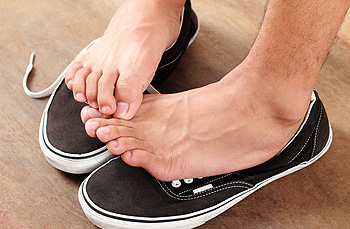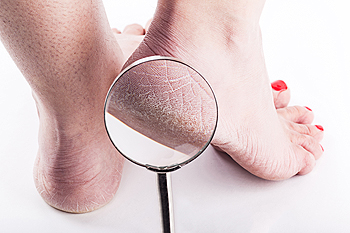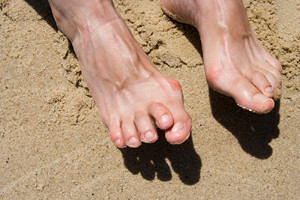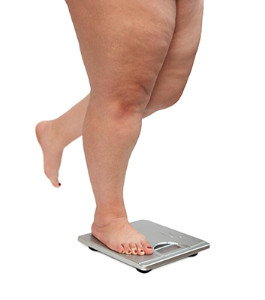Items filtered by date: February 2018
Causes of Athlete’s Foot
 If the skin between the toes starts to become itchy and sore, you may have a condition referred to as athlete’s foot. Athlete's foot is caused by a fungal infection, and may produce unsightly blisters, in addition to cracked and bleeding skin. It’s a contagious infection, and it commonly lingers on shower floors, so it’s advised to wear protective shoes to prevent the fungus from spreading. If you have sweaty feet, you may be susceptible in acquiring this condition. It’s important to treat athlete’s foot as soon as any symptoms appear, and this can be accomplished by using antifungal powders and sprays. There are ways to prevent this condition, including thoroughly drying the feet after washing them in warm water, wearing cotton socks, and using a different towel specifically used for your feet. If you have diabetes or find that general remedies are ineffective, please consult a podiatrist for the best treatment options for severe athlete’s foot.
If the skin between the toes starts to become itchy and sore, you may have a condition referred to as athlete’s foot. Athlete's foot is caused by a fungal infection, and may produce unsightly blisters, in addition to cracked and bleeding skin. It’s a contagious infection, and it commonly lingers on shower floors, so it’s advised to wear protective shoes to prevent the fungus from spreading. If you have sweaty feet, you may be susceptible in acquiring this condition. It’s important to treat athlete’s foot as soon as any symptoms appear, and this can be accomplished by using antifungal powders and sprays. There are ways to prevent this condition, including thoroughly drying the feet after washing them in warm water, wearing cotton socks, and using a different towel specifically used for your feet. If you have diabetes or find that general remedies are ineffective, please consult a podiatrist for the best treatment options for severe athlete’s foot.
Athlete’s foot is an inconvenient condition that can be easily reduced with the proper treatment. If you have any concerns about your feet and ankles, contact Dr. Mark Gagnon from Advanced Podiatry. Our doctor will treat your foot and ankle needs.
Athlete’s Foot: The Sole Story
Athlete's foot, also known as tinea pedis, can be an extremely contagious foot infection. It is commonly contracted in public changing areas and bathrooms, dormitory style living quarters, around locker rooms and public swimming pools, or anywhere your feet often come into contact with other people.
Solutions to Combat Athlete’s Foot
- Hydrate your feet by using lotion
- Exfoliate
- Buff off nails
- Use of anti-fungal products
- Examine your feet and visit your doctor if any suspicious blisters or cuts develop
Athlete’s foot can cause many irritating symptoms such as dry and flaking skin, itching, and redness. Some more severe symptoms can include bleeding and cracked skin, intense itching and burning, and even pain when walking. In the worst cases, Athlete’s foot can cause blistering as well. Speak to your podiatrist for a better understanding of the different causes of Athlete’s foot, as well as help in determining which treatment options are best for you.
If you have any questions please feel free to contact one of our offices located in Crestwood, Orland Park, and Summit, IL . We offer the newest diagnostic and treatment technologies for all your foot and ankle needs.
Pregnancy and Cracked Heels
 Pregnancy can be an incredible experience, but there may be occasional foot issues that many women encounter. Cracked heels is a common ailment, most often due to the additional weight the feet must endure. The skin on the heels starts to split, possible due to a deficiency in vitamin A, zinc, and fish oil. Wearing shoes that have adequate cushioning and support will help the feet to feel better and it’s helpful to avoid going barefoot, which can cause the fissures, or cracks to worsen. If you encounter this ailment, there are several treatment options available. The heels will feel better if a moisturizer is applied after soaking the feet in warm, soapy water. Additionally, having your feet massaged with a warm essential oil may be beneficial.
Pregnancy can be an incredible experience, but there may be occasional foot issues that many women encounter. Cracked heels is a common ailment, most often due to the additional weight the feet must endure. The skin on the heels starts to split, possible due to a deficiency in vitamin A, zinc, and fish oil. Wearing shoes that have adequate cushioning and support will help the feet to feel better and it’s helpful to avoid going barefoot, which can cause the fissures, or cracks to worsen. If you encounter this ailment, there are several treatment options available. The heels will feel better if a moisturizer is applied after soaking the feet in warm, soapy water. Additionally, having your feet massaged with a warm essential oil may be beneficial.
Cracked heels are unsightly and can cause further damage to your shoes and feet. If you have any concerns, contact Dr. Mark Gagnon from Advanced Podiatry. Our doctor can provide the care you need to keep you pain-free and on your feet.
Cracked Heels
Cracked heels appear unappealing and can make it harder for you walk around in sandals. Aside from looking unpleasant, cracked heels can also tear stockings, socks, and wear out your shoes. There are several methods to help restore a cracked heel and prevent further damage.
How Do You Get Them?
Dry skin is the number one culprit in creating cracked heels. Many athletes, walkers, joggers, and even swimmers suffer from cracked heels. Age and skin oil production play a role to getting cracked heels as well.
Promote Healing
Over the counter medicines can help, especially for those that need instant relief or who suffer from chronic dry feet.
Wear Socks – Wearing socks with medicated creams helps lock in moisture.
Moisturizers – Applying both day and night will help alleviate dryness which causes cracking.
Pumice Stones – These exfoliate and remove dead skin, which allows for smoother moisturizer application and better absorption into the skin.
Change in Diet
Eating healthy with a well-balanced diet will give the skin a fresh and radiant look. Your body responds to the kinds of food you ingest. Omega-3 fatty acids and zinc supplements can also revitalize skin tissue.
Most importantly, seek professional help if unsure how to proceed in treating cracked heels. A podiatrist will help you with any questions or information needed.
If you have any questions, please feel free to contact one of our offices located in Crestwood, Orland Park, and Summit, IL . We offer the newest diagnostic and treatment technologies for all your foot care needs.
Causes of Hammertoe
 Hammertoe is caused by a deformity that bends the toes, causing them to be crooked. The joint affected is located at the bottom of the big toe and can often appear unsightly. The skin on top of the toes may look swollen, and corns and calluses will often form there, typically caused by friction as it rubs against the shoes. Causes of hammertoe are commonly due to shoes fitting poorly, which may cause the toes to be constricted for long periods of time. There may be a predisposed genetic trait that may cause this condition, in addition to diabetic patients and arthritis sufferers being prone to hammertoe. There are numerous treatment options available, depending on the severity of this condition. A consultation with a podiatrist is suggested for a proper diagnosis.
Hammertoe is caused by a deformity that bends the toes, causing them to be crooked. The joint affected is located at the bottom of the big toe and can often appear unsightly. The skin on top of the toes may look swollen, and corns and calluses will often form there, typically caused by friction as it rubs against the shoes. Causes of hammertoe are commonly due to shoes fitting poorly, which may cause the toes to be constricted for long periods of time. There may be a predisposed genetic trait that may cause this condition, in addition to diabetic patients and arthritis sufferers being prone to hammertoe. There are numerous treatment options available, depending on the severity of this condition. A consultation with a podiatrist is suggested for a proper diagnosis.
Hammertoe
Hammertoes can be a painful condition to live with. For more information, contact Dr. Mark Gagnon from Advanced Podiatry. Our doctor will answer any of your foot- and ankle-related questions.
Hammertoe is a foot deformity that affects the joints of the second, third, fourth, or fifth toes of your feet. It is a painful foot condition in which these toes curl and arch up, which can often lead to pain when wearing footwear.
Symptoms
- Pain in the affected toes
- Development of corns or calluses due to friction
- Inflammation
- Redness
- Contracture of the toes
Causes
Genetics – People who are genetically predisposed to hammertoe are often more susceptible
Arthritis – Because arthritis affects the joints in your toes, further deformities stemming from arthritis can occur
Trauma – Direct trauma to the toes could potentially lead to hammertoe
Ill-fitting shoes – Undue pressure on the front of the toes from ill-fitting shoes can potentially lead to the development of hammertoe
Treatment
Orthotics – Custom made inserts can be used to help relieve pressure placed on the toes and therefore relieve some of the pain associated with it
Medications – Oral medications such as anti-inflammatories or NSAIDs could be used to treat the pain and inflammation hammertoes causes. Injections of corticosteroids are also sometimes used
Surgery – In more severe cases where the hammertoes have become more rigid, foot surgery is a potential option
If you have any questions please contact one of our offices located in Crestwood, Orland Park, and Summit, IL . We offer the newest diagnostic and treatment technologies for all your foot and ankle needs.
Foot Conditions Caused by Obesity
 Fallen arches are a common result of being obese. The feet provide a natural support system for the body, and imbalance may occur due to the excess weight the feet must withstand. The feet may also grow in size due to excess pressure and swelling. The ankles will be surrounded by fat tissues and cells, which may cause immense pain and difficulty walking. Pressure that settles on the ankle often makes it painful to wear shoes. Bending over to put them on may be challenging because of the additional weight the body must endure. Fat and sugar deposits surrounding the ankle may weaken the structure of the foot, commonly causing serious complications and discomfort. This condition may be prevented by implementing dietary and lifestyle changes, thus improving not only the general health of the feet, but the rest of the body as well.
Fallen arches are a common result of being obese. The feet provide a natural support system for the body, and imbalance may occur due to the excess weight the feet must withstand. The feet may also grow in size due to excess pressure and swelling. The ankles will be surrounded by fat tissues and cells, which may cause immense pain and difficulty walking. Pressure that settles on the ankle often makes it painful to wear shoes. Bending over to put them on may be challenging because of the additional weight the body must endure. Fat and sugar deposits surrounding the ankle may weaken the structure of the foot, commonly causing serious complications and discomfort. This condition may be prevented by implementing dietary and lifestyle changes, thus improving not only the general health of the feet, but the rest of the body as well.
Obesity has become very problematic at this point in time and can have extremely negative effects on the feet. If you’re an obese individual and are concerned about your feet, contact Dr. Mark Gagnon from Advanced Podiatry. Our doctor can provide the care you need to keep you pain-free and on your feet.
Obesity and Your Feet
Since your feet are what support your entire weight when standing, any additional weight can result in pain and swelling. Being overweight is one of the main contributors to foot complications.
Problems & Complications
Extra Weight – Even putting on just a few extra pounds could create serious complications for your feet. As your weight increases, your balance and body will shift, creating new stresses on your feet. This uneven weight distribution can cause pain, even while doing the simplest tasks, such as walking.
Diabetes – People who are overweight are at serious risk of developing type-2 diabetes, which has a drastic impact on the health of your feet. As you get older, your diabetes might worsen, which could lead to loss of feeling in your feet, sores, and bruises. You could also become more prone to various infections.
Plantar fasciitis – Pressure and stress that is placed on muscles, joints, and tendons can trigger plantar fasciitis, which is an inflammation of tissue that forms along the bottom of the foot.
If you have any questions please feel free to contact one of our offices located in Crestwood, Orland Park, and Summit, IL . We offer the newest diagnostic and treatment technologies for all your foot and ankle needs.
